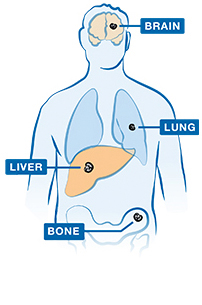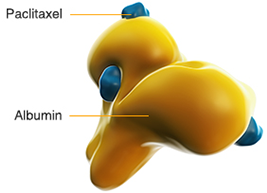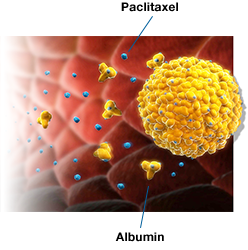ABRAXANE and Advanced Non–Small
Cell Lung Cancer
What should I know about advanced non–small cell lung cancer?

Most common places in the body where advanced NSCLC may spread.
What is advanced non–small cell lung cancer (NSCLC)?
Lung cancer is cancer that starts in the lungs. It starts as pre-cancerous or abnormal cells in the lung. Over time, abnormal cells in the lungs grow out of control and form a tumor (TOO-mer). A tumor is an abnormal mass of tissue.
There are 2 main types of lung cancer:
- Non–small cell lung cancer (NSCLC)
- Small cell lung cancer
NSCLC is the most common type of lung cancer. About 85% of lung cancers are NSCLC. In people with NSCLC, the cancer may spread from the lungs to other parts of the body. This is called advanced NSCLC. This type of cancer is also known as metastatic (met-tuh-STA-tik) or stage 4 lung cancer.
Most common places in the body where advanced NSCLC may spread.

How many people have advanced non–small cell lung cancer?
If you have advanced non–small cell lung cancer (NSCLC), you are not alone. About 190,000 people in the United States are diagnosed with NSCLC each year. Nearly 80% are diagnosed after the cancer has spread from the lungs to other parts of the body or becomes advanced NSCLC.
Are some people more at risk for lung cancer?
There are certain factors that affect a person’s chance of getting lung cancer. It is important to know that having 1 or more risk factors does not mean that you will definitely get lung cancer. And some people may get this type of cancer even if they don’t have any risk factors.
In addition to a person’s age, gender, race, and family history—all things that can’t be changed—there are risk factors for lung cancer that are considered lifestyle factors. This means that they can be controlled to some degree.
When your body is exposed to other things, like pollutants and certain types of cancer treatments, you may also have a greater risk for lung cancer. These include:
I am a caregiver. Where can I find support?
Your role as a caregiver of a person with advanced cancer is one of the most important roles you will fill in your life. It is rewarding to support your loved one through his or her experience. It is also likely to be challenging. While you put your energy and efforts into caring for your loved one, who cares for you?
Asking for help is critical in your role as caregiver. You may have friends or family members who are available to help you with the physical and emotional demands of caregiving. They may just be waiting for you to ask. There are also support groups that you can reach out to for answers to questions, to form connections with others, and to help you feel less alone.
Learn more about resources and support for caregivers.
What is ABRAXANE?
ABRAXANE is a prescription medicine used to treat advanced non–small cell lung cancer (NSCLC), in combination with carboplatin (KAR-boh-pla-tin), in people who cannot be treated with surgery or radiation.
ABRAXANE is a chemotherapy (KEE-moh-THAYR-uh-pee). Chemotherapy is a type of medicine that is used to keep cancer cells from growing or to kill cancer cells. Treatment with ABRAXANE plus carboplatin may help control or slow the spread of cancer cells.
Your doctor may recommend treatment with ABRAXANE + carboplatin based on your stage of cancer, your response to prior therapy, and your overall health. Only your doctor can help you decide if ABRAXANE + carboplatin is right for you.
What is in ABRAXANE?

The medicine in ABRAXANE,
paclitaxel, is bound to albumin.
Illustrative purposes only.
ABRAXANE is a different formulation of the cancer-fighting medicine paclitaxel (PAK-li-TAK-sel). ABRAXANE is made by binding paclitaxel to albumin (al-BYOO-min). Albumin is a protein found in the blood.
The medicine in ABRAXANE, paclitaxel, is bound to albumin.
Illustrative purposes only.

Here is what this means to you:
- Because ABRAXANE is bound to albumin, no solvents are needed to dissolve it
- Solvents are chemicals that dissolve some medicines so that they can be given by infusion (in-FYOO-zhun)
- Some solvents can cause allergic reactions
- Since ABRAXANE does not contain solvents, it is not usually necessary to take medicines to prevent allergic reactions before ABRAXANE is given. These medicines are called premedication
It is important to know that allergic reactions can occur with ABRAXANE. Premedication may be needed if you have had an allergic reaction. Allergic reactions may be severe and can lead to death. In case of severe allergic reaction, ABRAXANE should not be used again.
How does ABRAXANE work?

ABRAXANE travels through the bloodstream to reach cells in many parts of the body, including cancer cells.
Illustrative purposes only.
ABRAXANE may help stop cancer cells from dividing and making new cells. ABRAXANE works by blocking the action of proteins called microtubules (MY-kroh-TOO-byools). These proteins help cells divide.
Systemic (sis-TEH-mik) treatments like ABRAXANE are used to treat metastatic (meh-tuh-STA-tik) cancer. This is cancer that has spread from one part of the body to another. It is also known as advanced or stage 4 cancer. Systemic treatments travel through the bloodstream. This makes it possible to reach cells in many parts of the body, including cancer cells. ABRAXANE may also affect normal cells. This may cause side effects.
ABRAXANE travels through the bloodstream to reach cells in many parts of the body, including cancer cells.
Illustrative purposes only.

How are ABRAXANE and carboplatin given?
ABRAXANE and carboplatin are given by intravenous (IN-truh-VEE-nus), or IV, infusion (in-FYOO-zhun). To begin the infusion:
- A nurse inserts a thin, soft tube into your vein to give the medicine. This is often called an IV. If you have a central line in place, the nurse will use that to give you the medicine
- ABRAXANE flows through the IV into your bloodstream
- On the days you get carboplatin, it is given right after ABRAXANE
- After each infusion, the nurse removes the IV or the device that delivered the medicines through your central line. Your central line or port stays in place

Treatment with ABRAXANE can cause irritation where the medicine is injected (injection site reactions). You should be monitored by your doctor or nurse during and after you receive ABRAXANE to make sure no problems occur at the injection site. In some cases, these problems occurred 7 to 10 days after the medicine was injected.
Your treatment with ABRAXANE will be given in your doctor’s office, at a hospital, or at an infusion center. Each infusion of ABRAXANE takes 30 minutes. Tests, checkups, or waiting time may affect the length of treatment sessions.

How often will I be given ABRAXANE + carboplatin?

ABRAXANE is given once a week for 3 weeks in a row during a 21-day treatment cycle:
- ABRAXANE is given on days 1, 8, and 15
- Carboplatin (KAR-boh-pla-tin) is given only on day 1
Your doctor will decide how many cycles you will get.




